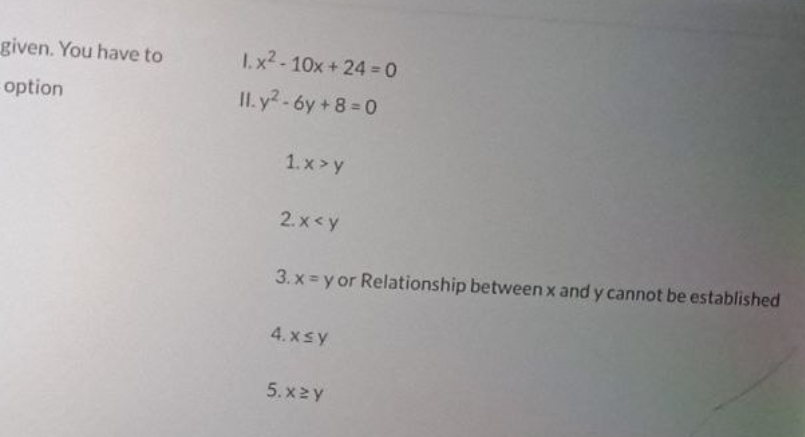Given the equations x^2 - 10x + 24 = 0 and y^2 - 6y + 8 = 0, determine the relationship between x and y. Options: 1. x > y, 2. x < y, 3. x = y or relationship cannot be established... Given the equations x^2 - 10x + 24 = 0 and y^2 - 6y + 8 = 0, determine the relationship between x and y. Options: 1. x > y, 2. x < y, 3. x = y or relationship cannot be established, 4. x ≤ y, 5. x ≥ y.

Understand the Problem
The question is asking us to determine the relationship between the variables x and y based on the two given quadratic equations. We need to evaluate both equations and analyze how the values of x and y compare to each other.
Answer
The relationship is $x \geq y$.
Answer for screen readers
The relationship between (x) and (y) is established as (x \geq y).
Steps to Solve
-
Solve the first quadratic equation for x
The first equation is given by:
$$ x^2 - 10x + 24 = 0 $$
We will use the quadratic formula:
$$ x = \frac{-b \pm \sqrt{b^2 - 4ac}}{2a} $$
Here, (a = 1), (b = -10), and (c = 24). -
Calculate the discriminant
First, calculate the discriminant, (D), which is given by:
$$ D = b^2 - 4ac $$
Substituting the values:
$$ D = (-10)^2 - 4(1)(24) $$
$$ D = 100 - 96 = 4 $$ -
Find the values of x
Since the discriminant is positive, we will have two real roots.
$$ x = \frac{10 \pm \sqrt{4}}{2} = \frac{10 \pm 2}{2} $$
This gives us:
$$ x_1 = \frac{12}{2} = 6 $$
$$ x_2 = \frac{8}{2} = 4 $$
Thus, the possible values for (x) are (6) and (4).
-
Solve the second quadratic equation for y
The second equation is given by:
$$ y^2 - 6y + 8 = 0 $$
We will again use the quadratic formula:
Here, (a = 1), (b = -6), and (c = 8). -
Calculate the discriminant for y
Calculate the discriminant, (D'):
$$ D' = (-6)^2 - 4(1)(8) $$
$$ D' = 36 - 32 = 4 $$ -
Find the values of y
Since the discriminant is also positive, we calculate the roots:
$$ y = \frac{6 \pm \sqrt{4}}{2} = \frac{6 \pm 2}{2} $$
This gives us:
$$ y_1 = \frac{8}{2} = 4 $$
$$ y_2 = \frac{4}{2} = 2 $$
Thus, the possible values for (y) are (4) and (2).
- Compare the values of x and y
Now we have:
- For (x), possible values: (6) and (4)
- For (y), possible values: (4) and (2)
We analyze the relationships:
- If (x = 6), then (x > y).
- If (x = 4), then (x = y).
This leads us to conclude that (x) can either be greater than (y) or equal to (y).
The relationship between (x) and (y) is established as (x \geq y).
More Information
This means that depending on the values of (x) and (y), (x) can either be greater than or equal to (y). Thus, we cannot establish a definitive order without specific values but can say at minimum that (x) is always at least as much as (y).
Tips
Common mistakes include:
- Forgetting to check both roots of the quadratic equations.
- Assuming specific relationships without evaluating all outcomes.
- Miscalculating the discriminant, which can lead to incorrect conclusions about the nature of the roots.
AI-generated content may contain errors. Please verify critical information